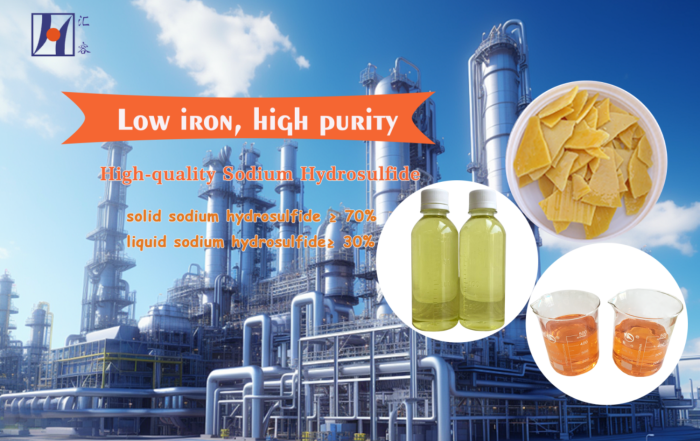Ⅰ. What Are The Characteristics And Properties of Sodium Hydrosulfide?
Sodium hydrosulfide (NaHS) is an inorganic compound with the following characteristics and properties:
1. Chemical properties: Sodium hydrosulfide is a strong base that is easily soluble in water and rapidly hydrolyzes to produce hydrogen sulfide gas (H2S). It can react with many metal ions to form corresponding sulfide precipitates or solutions. Sodium hydrosulfide can also undergo substitution reactions with some organic compounds, such as electrophilic substitution, amidation reaction of acyl chlorides, and reduction reaction of saturated carbonyl compounds. In addition, sodium hydrosulfide can also be oxidized to sodium sulfate by oxidants.
2. Physical properties: Sodium hydrosulfide is a colorless crystal or crystalline powder that is relatively stable at room temperature. It is insoluble in organic solvents and forms an alkaline solution when dissolved in water. Sodium hydrosulfide has a relatively high density and a melting point of about 350°C. Its powder form has a distinct rotten egg smell, which is due to the hydrogen sulfide gas generated by its hydrolysis.
3. Chemical stability: Sodium hydrosulfide is relatively stable at room temperature and can be stored for a long time in a dry environment. However, it has a certain degree of moisture sensitivity and is easy to absorb moisture and deteriorate. In addition, sodium hydrosulfide is also susceptible to oxidation by oxidants in the air to generate sodium sulfate.
4. Safety: Sodium hydrosulfide has a certain degree of toxicity, especially the hydrogen sulfide gas generated by its hydrolysis, which has a certain irritating and harmful effect on the human respiratory system and nervous system. Therefore, when using sodium hydrosulfide, care should be taken to avoid inhaling hydrogen sulfide gas. In addition, sodium hydrosulfide is also corrosive, and it should be rinsed with plenty of clean water in time when it comes into contact with the skin and eyes. During storage and operation, appropriate protective measures should be taken, such as wearing protective gloves and respirators.
5. Application areas: Sodium hydrosulfide has a wide range of applications in industry. It can be used as a reducing agent in the sulfide industry, and is often used in metal purification, pharmaceutical synthesis, oil field mining, sewage treatment, and decontamination of metal surfaces. Sodium hydrosulfide can also be used as an analytical reagent for detecting sulfides in metal ions or organic compounds. In addition, sodium hydrosulfide is also widely used in academic research as a commonly used experimental reagent.
In summary, sodium hydrosulfide is an active inorganic compound with the characteristics of strong alkalinity, easy solubility in water and generation of hydrogen sulfide gas. Its main application areas include metal purification, pharmaceutical synthesis, sewage treatment and analytical chemistry. When using sodium hydrosulfide, appropriate safety measures need to be taken to avoid contact with its hydrolysis product hydrogen sulfide gas, and pay attention to the safety of storage and operation.
Ⅱ. Prospects of sodium hydrosulfide in the chemical industry
In the future, with the continuous improvement of environmental protection awareness, the demand for wastewater treatment technology will increase. Sodium hydrosulfide, as a chemical widely used in wastewater treatment, will continue to receive attention and use. In addition, with the advancement of industrial technology, the preparation method of sodium hydrosulfide will become more efficient and environmentally friendly, thereby improving the economy and sustainability of its application.
In addition, with the continuous emergence of new materials and new technologies, the application of sodium hydrosulfide in other fields will continue to expand. For example, in the energy field, sodium hydrosulfide can be used in the preparation of energy storage equipment, thereby realizing efficient utilization and storage of energy; in the electronics field, sodium hydrosulfide can be used as a material resistance reducing agent to improve the conductivity of electronic devices. The development and research of these applications need to be further deepened.
In short, sodium hydrosulfide has a wide range of applications in the chemical industry, including sulfiding agents, wastewater treatment agents and organic synthesis reagents. With the improvement of environmental protection awareness and the emergence of new materials and new technologies, the application prospects of sodium hydrosulfide are very broad. In the future, we have reason to believe that the application of sodium hydrosulfide will be further expanded and play a greater role in the chemical industry.
Ⅲ. Common detection methods of sodium hydrosulfide
Appearance detection: A preliminary evaluation can be made by directly observing the appearance of the sodium hydrosulfide sample, including color, shape, particle size, etc.
Property detection: The sodium hydrosulfide sample can be smelled to determine whether there is an obvious smell of hydrogen sulfide.
Purity detection: Commonly used purity detection methods include gas chromatography, homogenization titration, ion chromatography, molecular photometry, etc. Among them, gas chromatography can separate and determine the impurities in sodium hydrosulfide, and then calculate the purity.




